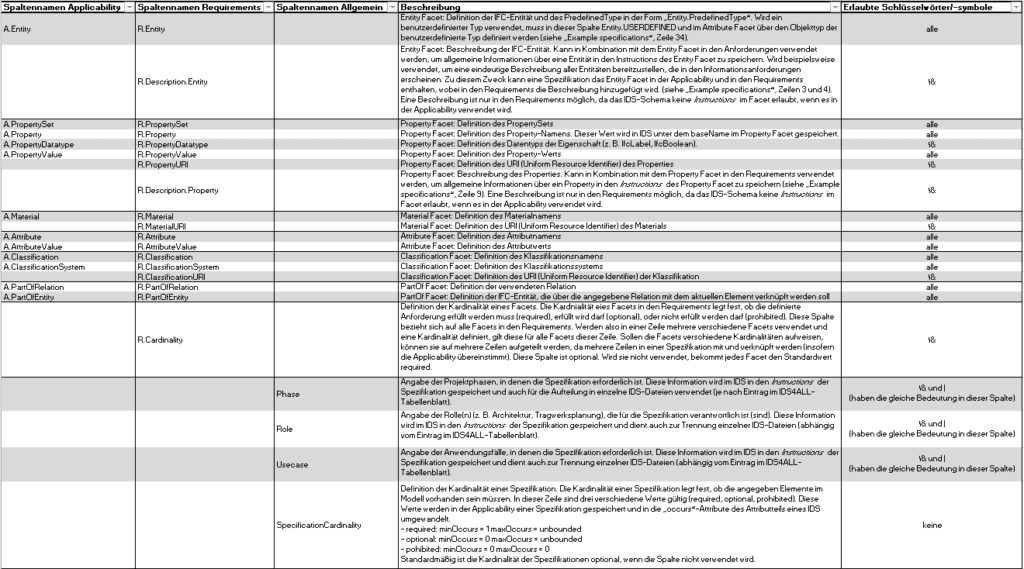Introduction
This IDS4ALL converter, developed by Simon Fischer, Harald Urban, Konstantin Höbart and Christian Schranz from the Digital Construction Process research department at TU Wien (https://www.tuwien.at/cee/ibb/zdb), converts information requirements from an Excel file into an IDS file. In practice, information requirements are often defined in tabular form in Excel. This tool is designed to help transfer these easily into IDS and use the full functionality of IDS. The aim is to use an Excel file structure that is similar to the existing structures for information requirements in order to facilitate adaptation to IDS.
The converter converts information requirements defined according to the “IDS4ALL template” into an IDS file.
This template contains five worksheets:
IDS4ALL: Defines general information (metadata) of the IDS file. This worksheet and its structure are predefined and must be adhered to.
Template: Empty template with all possible columns without specifications
Example specifications: Contains examples of all IDS4ALL converter functionalities described in the user manual. Can also be used as a template sheet.
User manual: Explanation/instructions in English
User manual: Explanation/instructions in German
The required structure is described in detail below using examples from the “Example specifications” worksheet.
Structure of the “Example specifications” worksheet
The “Example specifications” worksheet introduces individual columns for possible entries in an IDS facet. In a classic or traditional information requirements table, there is a column for the IFC entity that defines the Applicability and columns for the PropertySet, Property Name, Data Type and Property Value to define the Requirements. In the same way, columns are introduced for the other IDS facets for both the Applicability and the Requirements. The names of the columns are predefined and must be adhered to. Columns for the Applicability start with “A”. Columns for the requirements start with “R”. Additional general columns (Phase, Role, Usecase, SpecificationCardinality) have no prefix. The order of the columns in the Excel table is not predefined. Likewise, not all columns need to be present. Columns of IDS facets that are not required can be removed or omitted, allowing the Excel file to be kept simple. This allows the IDS4ALL converter to be used for both simple classic information requirements and more complex requirements that utilize the full potential of IDS. However, if a facet is used, it must be ensured that all required columns of the facet are also used. For example, the entries “PropertySet” and “Property” are required for the property facet. If the property facet is used, at least these two columns must be filled in.
Specifications are defined line by line. Different lines with the same applicability are combined into one specification. If the different lines relate to different requirements, they are combined into one specification using “and” logic. However, different lines often also relate to the same requirements, e.g. lists of possible property values are often listed in separate lines. Therefore, different lines can also be used for the columns R.AttributeValue and R.PropertyValue to list different possible values. If all other entries in the lines are the same, the values in the different lines are merged into a list of possible values using an “Or” logic (see “Example specifications”, lines 12-21 and 22-31). The second way to define lists of “Or” values is to use the | separator (see description of keywords/symbols).
The order of the lines is not specified. Empty lines are also permitted. These are ignored by the converter (see “Example specifications”, lines 55 and 61).
In general, the line structure is not hierarchical. Each line must be able to stand on its own. This means that each line must contain all information and no information is taken from previous lines. However, it is possible to structure the data using header lines for a new entity or a new property set as in the “Example specifications”. A heading line in the applicability (see “Example specifications”, line 5) creates an additional general specification in which all the information from the more specific specifications is brought together. It does not replace the more specific specification, but is an additional specification. A heading line in the requirements (see “Example specifications”, line 6) does not create a new specification. Instead, it is merged with the more detailed specifications below it. However, if you split your data into different IDS files using the general columns, make sure that the general columns are also filled in for these heading lines (should match the general data of a more specific specification, regardless of which more specific specification). Otherwise the rows will not be merged and incomplete facets will be generated.
Below you will find a list of the predefined column names, divided into applicability, requirements and general information, including an explanation:

Keywords/symbols
Keywords/symbols are required to define more than just simple values in individual cells. The symbols always indicate a complex restriction or special processing of the values in the cell. They are therefore not permitted as normal text. The symbols are not permitted in every column. The list above shows which symbols are permitted in which column.

Restrictions
The decimal separator of a numerical value must be a point or a comma.
It is not possible to define different IFC versions for different specifications. The IFC version specified in the IDS4ALL worksheet is used for each specification.
The name of a specification cannot be user-defined. It is generated automatically from the IFC entity.
It is not possible to define user-defined values for the purpose and milestone of the IDS. These values are generated automatically from the general columns. The phases are saved as a milestone and the combination of roles and use cases as a purpose.
